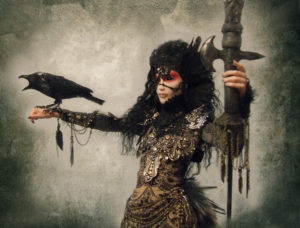
A modern artistic representation of the Morrigu.
The Morrigu, who was also known as the Morrigan, was a Celtic ‘Triple Goddess’. Her name meant a variation of either “phantom queen” or “great queen”. She was known as both an independent deity and as three sisters: Anu the Maiden, Badh the Mother and Macha the Crone. Each signified a link to the circle of life as each role held an association with aspects of life and death. The Morrigu was thought to predict the fate of warriors in battle and would appear above a battlefield in the shape of a crow. It is this association that has likened her to the Nordic Valkyries and the Germanic Norns, as all would appear above a battlefield in the shape of a bird. Her association with cows also represented her link to sovereignty and represented the wealth of the land where she was seen.
The Morrigu is also closely linked with other well-known mythological characters. These include the Celtic King Arthur and the Hebrew deity Lilith. A branch of Arthurian tales shows the Morrigu as an unbiased spirit who took Arthur to Avalon. While she was neither good or evil, she could be corrupted to a side under persuasion. These tales link to her personification in Irish mythology and show her as a shapeshifter who could transform from a young maiden to an old woman, or transition from a woman to a crow. The ability to turn into a crone at will was thought to inspire fear in men and would have caused disrespect to older women. Our knowledge of a connection to Lilith is seen in Latin texts, such as the Jewish Book of Isaiah. This text shows the use of the word ‘Lamia’ to describe a monster in female form and uses the example of a Morrigu to personify this. In ancient Greece, Lamia was the beautiful Queen of Libya who became a child devouring daemon after Hera cursed her for her relationship with Zeus. In Hebrew, the word ‘Lamia’ translates to Lilith. The use of the Morrigu in this text in connection to Lamia shows her as a fearful deity, rather than the giver of life that we see in other regions.
The earliest example of the Morrigu being directly referenced as an individual is from the Ulster Cycle in the Táin Bó Regamna. This text is otherwise known as The Cattle Raid of Regamain. This narrative introduces the warrior Cú Chulainn who sees her as she removes a cow from his terrority, referencing her connections to cattle and their depiction of her sovereignty. This slight offends her and she leaves the field as a black cow after foretelling a coming battle in which he will be defeated. Chulainn rides out to meet his enemies and on the journey, he encounters the Morrigu as a hag washing his bloody armour in a river ford. This action can be construed as an omen of his death. He is mortally wounded in the battle and ties himself to a standing stone before his death in order to remain upright. Only when a crow, believed to be the Morrigu, lands on his shoulder do his enemies believe that he has died.
Archaeological evidence tells us that her existence dates back to before the 2nd millennium BCE. This evidence portrays the Triple Goddess as a dominant deity across much of Europe. For example, there have been stone slabs found in Spain, France, Portugal and England that show a Celtic goddess with feminine eyes, breasts and a crow’s beak. Her breasts were said to represent her actions of providing nourishment to the living in her role as Anu the Maiden. The Irish Da Chich Annan hills in County Kerry are said to be named after them.
-Devon Allen
Junior Girl
Girl Museum Inc.
